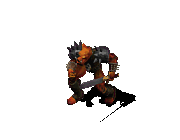CLIMATE/TERRAIN: Underdark
FREQUENCY: Very rare
ORGANIZATION: Solitary
ACTIVITY CYCLE: Any
DIET: Carnivore, fungivore
INTELLIGENCE: Non- (0)
TREASURE: Nil
ALIGNMENT: Neutral
NO. APPEARING: 1
ARMOR CLASS: 10 or special
MOVEMENT: 1
HIT DICE: 1+1 to 2+2
THAC0: 19
NO. OF ATTACKS: 1
DAMAGE/ATTACK: 1d2
SPECIAL ATTACKS: See below
SPECIAL DEFENSES: See below
MAGIC RESISTANCE: Nil
SIZE: S (18 diameter)
MORALE: Unreliable (2?4)
XP VALUE: 175
Also called the coffin shell creature, a carapace is an aggressive,
mobile fungus native to the Underdark. It adapts itself on contact
with almost any vertebrate creature, from reptiles to mammals to
fish, creating a symbiotic exoskeleton. It does not attach itself to
invertebrates, such as insects, spiders, or octopi. In its natural
state, the carapace looks like a soft, gray spongy mass about a foot
in diameter, though it can extend tendrils from its central mass to
snare a host, then pull itself into contact with the host?s body.
Combat: The carapace lies hidden in beds of other fungi or
clings to cavern walls and ceilings. In its natural state, the cara-pace
has an Armor Class of 10. Whenever the carapace success-fully
strikes a target, or is struck by the unprotected living flesh
of a predator or attacker, it creates a sticky, gluey bond between
the two creatures. Unless the fungus is dispatched within the
next round, the bond solidifies, and the carapace begins to
spread its mass out over the host?s skin. Attacks that physically
damage the spreading carapace inflict equal damage on the host
creature, though it can be destroyed without harm to the host by
a cure disease spell.
If the carapace is not removed within a certain time that
depends on the size of the host, it hardens into a protective horn-like
shell that improves the host?s Armor Class by 2 (for instance,
a giant snake with AC 6 would become AC 4). The carapace can
cover any size creature, given enough time, since it transforms
some of the host?s mass as well as spreading its own. The process
takes a single day for tiny creatures (size T), two days for small
creatures (size S), four days for man-sized creatures (size M), a
week to 10 days for large creatures (size L), at least two weeks for
huge creatures (size H), and up to a month for gargantuan crea-tures
(size G). When this process is complete, the host creature
permanently loses one point of Constitution. The host?s joints are
not stiffened, as the carapace adapts to the host?s body structure.
Once the host is entirely covered, the carapace cannot be
removed without damaging the host?s body. At this point the
carapace has become fully integrated with the host?s skin and has
no independent existence. A cure disease spell is no longer effec-tive
against it. After the carapace has covered the entire skin of
the host, the host body becomes noticeably thinner and paler; this
is when many of the host?s companions first notice any change.
The hardened carapace gives the host some benefits: it can regen-erate
the host at 1 hit point per round for up to a day in exchange
for another point of Constitution. It will do so to keep its host at
least half the host?s full hit points. (If the total number of hit
points regenerated by the carapace in one day is less than or
equal to the host?s Constitution, no Constitution is lost if the
number of regenerated hit points is less is rolled on 3d6).
The carapace absorbs poisons and mental attacks, making the
host immune to poisons, mind-affecting spells, and psionic
attacks. If the host is psionic, the carapace absorbs the host?s
PSPs as well. A hardened carapace is immune to fire, further
protecting the host.
Habitat/Society: The carapace, in its soft form, uses its limited
mobility to move about searching for hosts. It can crawl on walls
and ceilings and attach itself to almost any surface. It is attracted
by body heat and motion, and avoids direct sunlight and nega-tive
energy. When not attached to a host, the soft form of the
carapace can subsist for months on a diet of less-dangerous
fungus and slime-molds. When such fungi are abundant, a soft
carapace slowly grows to the 2+2 HD size, then divides into two
1+1 HD carapaces. In its soft state, the carapace is vulnerable to
spells effective against fungi, such as the 7th-level priest spell
sunray, and to subterranean creatures that eat fungi, such as
giant slugs, purple worms, and burburs.
A hardened carapace slowly leeches away the bones of the host,
becoming the host?s exoskeleton in a process that is not particu-larly
painful. As the carapace slowly fuses with the host?s spinal
and brain tissue, the host?s alignment shifts irreversibly to neutral,
though the host?s lawful or chaotic tendencies are unaffected.
Once the host dies, the host tissue within the carapace is con-sumed
by the growth of new spongy carapace fungus. When the
host?s body is entirely consumed (which may take several
weeks) the dead outer carapace splits, revealing one or more
new soft carapaces. The host body breeds a new carapace per 3
feet of height or body length.
Ecology: The carapace is a symbiont, thought to have been cre-ated
by a slime-lord of the tanar?ri long ago. Only the most des-perate
Underdark creature might join with a carapace, but slave-warriors
among the derro and aboleths are sometimes forced to
become their hosts.
?From DRAGON Magazine #227
Carapace
14
This would be kickass. That's all i need to say
------------------

Quote:
|
"Est Sularis Oth Mithas"-->Honour Is My Life
|